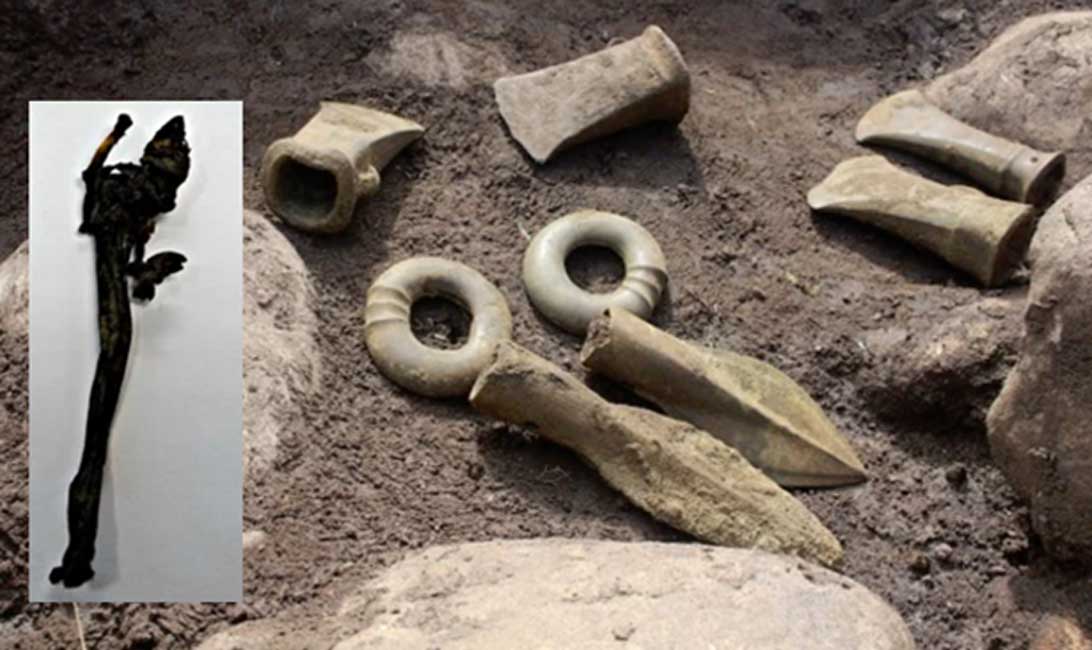3,000-Year-Old Pressed Flower Found Inside Axe Handle at Bronze Age Burial Site
Archaeologists have discovered a remarkable set of Bronze Age ritual offerings, which they described as ''absolutely jaw-dropping”, including jewelry, ornaments, weapons, and a pristine pressed flower that had been placed inside the hollow end of an axe handle.
The Guardian reports that the discovery was made at an excavation site in Lancashire. The people who created the offering were a farming community, who placed their ritual offerings in waterlogged sites. This kind of well-preserved hoard is rare and, until now, the researchers believed that Bronze Age votive offerings were primarily focused on metal. However, this finding reveals that the offerings could include a wide variety of other objects, such as food, clothing, and wooden items.
Among many impressive treasures, the researchers unearthed a thistle flower, which is a unique offering of its time, and surprisingly well-preserved. It was placed inside the hollow end of an axe handle, one of many discovered in the hoard, which had been filled with hazelnuts. Dr Ben Roberts, a lecturer at Durham University and the British Museum’s former curator of European Bronze Age collections, told The Guardian that the thistle flower is a very rare artifact from the Bronze Age. Flowers have been discovered in earlier graves, but during this specific period human remains were cremated and such offerings would normally be destroyed. In this case, the hoard was preserved because it was not directly linked to the burial site, but was a separate ritual offering.
In addition to the flower, the research team discovered a large number of axes, spearheads (with the blades still sharp), arm rings, bracelets and other ornaments.

Excavation site where Bronze Age ritual offerings were found. Credit: Dalya Alberge
Earlier this year, the researchers made another significant Bronze Age discovery, near Morecambe Bay, consisting of a burial site with many precious artifacts. It was during this excavation that the team of researchers had been alerted to the discovery of the new hoard by another metal detectorist about seven miles (11km) away. As Brendon Wilkins, an archeologist and the project director said:
“What really struck us was the serendipity,” he said. “Right at the same time, an absolutely jaw-dropping hoard came to light and allowed a team that was already in the field [to go there]. These sites are starting to come together, filling a big black hole in our knowledge. The items found in the hoard must now be assessed and analysed in a lab, before a coroner decides whether they can be officially designated as treasure. Then they’re offered up to local or national museums” [via The Guardian].
The team, which excavated at Morecambe Bay, also discovered a rare early Bronze Age funerary urn. Currently the researchers continue their analysis and they share news about the investigations on their Facebook page.

Morecambe Bay, England (public domain)
The University of Durham is very active with research on archaeological sites in the United Kingdom, but also other places like Egypt and Sudan. One of their most impressive discoveries of last year was made in northern England. As April Holloway from Ancient origins reported in November 30, 2013:
“Archaeologists from the University of Durham in northern England have found the remains of eighteen individuals at a dig on the City’s World Heritage Site, providing clear evidence of a mass grave dating back to Medieval times.
Archaeologists first thought the bodies had belonged to Durham Cathedral’s cemetery and had just been buried a bit beyond the boundaries of the present day burial site, but then they noticed features that indicated these were not regular burials.
The bodies demonstrated were packed closely together in an unorthodox layout and some were buried in a North to South alignment rather than an East to West alignment which is typical for conventional medieval burials.
"The bodies have been tipped into the earth without elaborate ceremony and they are tightly packed together and jumbled,” said Richard Annis, senior archaeologist, Archaeological Services Durham University.
At this stage, archaeologists are unclear about the circumstances in which the individuals died or why they would have been buried in a mass grave. It is possible that the individuals died of an infectious disease leading to a hasty burial, or perhaps it was something more sinister that took place.''
Top image: Main: Socketed axes were also discovered. Inset: The preserved thistle flower is believed to be about 3,000 years old. Credit: Dalya Alberge.


















